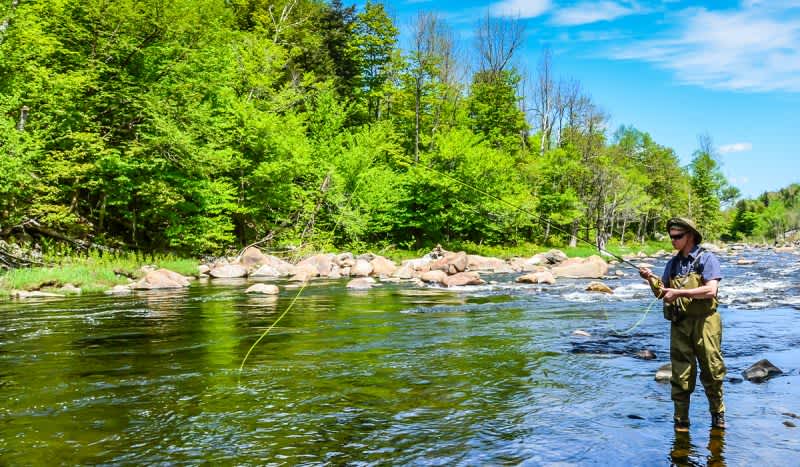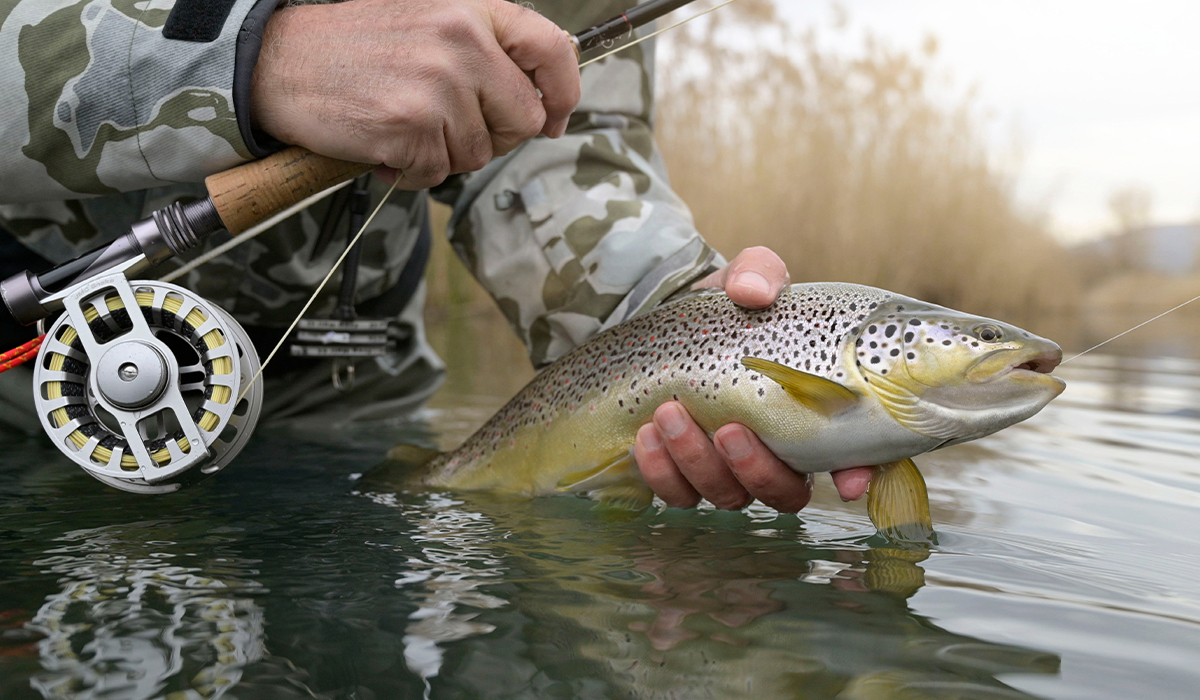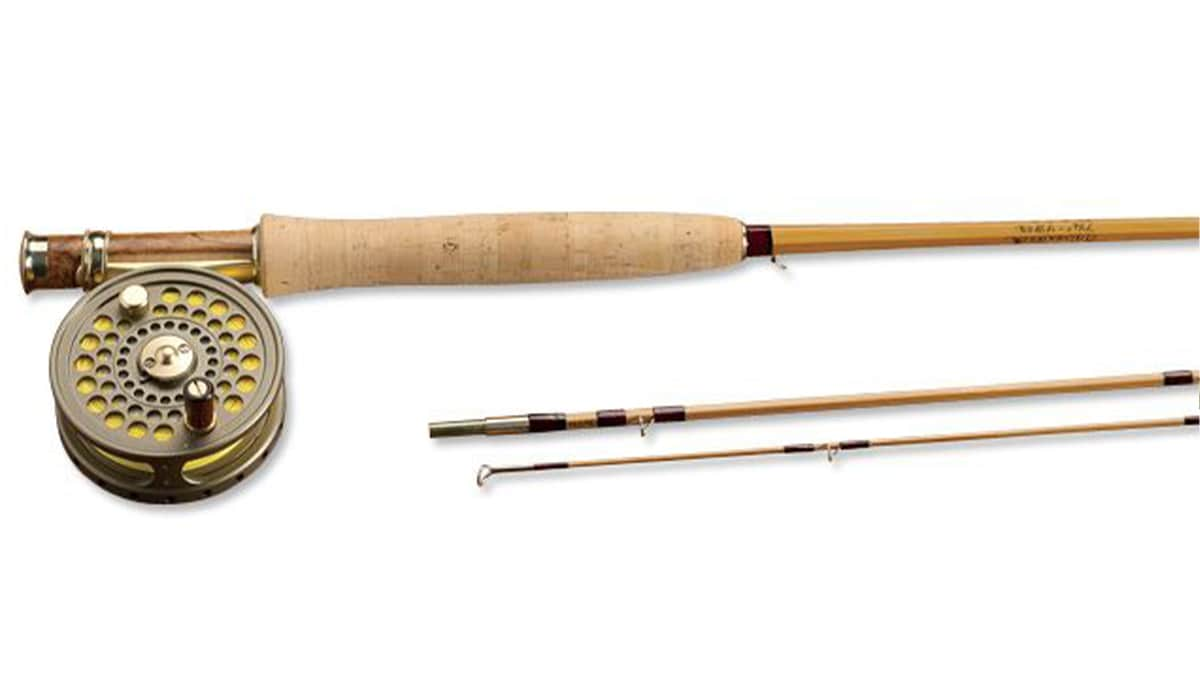
+
–
Table of Contents
1. Sage Pulse – Editor’s Pick
Finding a fly rod to fit everyone is a fool’s errand. There are just too many variables from angler to angler to make it a perfect fit for everyone. What the Sage Pulse does is tick as many boxes as possible, with a design that has multiple applications, forgiving features, and does so at a price that most anglers can absorb.
While the Pulse is a fast action rod, it isn’t configured as an ultra-stiff rod that newer anglers will find difficult to cast. Similarly, it isn’t so flimsy that intermediate and experienced fly anglers will find it lacking in the precision and power that they seek. It really is a sweet spot of fly rod design. A total of 15 configurations are available ranging from 7’6” 3wt to 9’6” 8wt. No matter where you plan to drop that bug, there’s a Sage Pulse rod to match whatever you find on the other end.
Pros/The Graphite IIIe backbone is appreciated in every weight rating
Cons/ Might lack the long-range casting ability some more experienced anglers might be looking for
Bottom Line/ It’s a Goldilocks fly rod – Everything is just right
2. Redington Path – Budget Pick
Value and fly fishing aren’t words that typically go together, but don’t let that fool you. You don’t have to break the bank to get into fly fishing. Being good at fly fishing doesn’t require a whole lot of money either. Like anything, the more in-depth you go, the more options you uncover, the more you can spend. All that said, the Redington Path fly rod offers a lot of performance for the money, and is certainly appointed well enough to get you on the water and into fish at a reasonable price. The medium-fast configuration is plenty forgiving and makes it a good option for beginning anglers to learn to cast.
Does it have the high-end features of other options, or the sleek appeal? No, but for a reliable fly rod at a reasonable price, this is it. Budget doesn’t mean you have to give up configurations either. The Path is available in multiple lengths from 3wt to 9wt, so you can even experiment with different weights before stepping up the quality of rod in your tube.
Pros/Forgiving design for beginning casters
Cons/ Lacks the high-end feel of some other options
Bottom Line/Lots of bang for the buck
3. Orvis Adirondack Bamboo – Nostalgic Pick
Modern materials and technologies have made fly rods more forgiving, affordable, and reliable than ever. It really is a marvel. Step back just a few generations, however, and fly rods looks drastically different. Orvis is holding on to that memory with the Adirondack Full-Flex Bamboo fly rod. Brace yourself, nostalgia doesn’t come cheap, but this 5wt, 7’6” two-piece rode is a great all-around option for the angler that wants to take a step back in time. Does it perform? Absolutely.
This fly rod isn’t about performance as much as it is romanticism. As an heirloom, it’s tough to beat a bamboo fly rod. That Orvis offers personalization, with your name being added to the bamboo blank for an additional fee, just sweetens the pot. Just like traditional archery, or hunting with a flintlock, there’s something to be said for doing it the way it used to be done. That it’s as beautiful a piece of outdoor equipment as has ever been built is just a bonus.
Pros/ A downright beautiful fly rod
Cons/ Bamboo worked great for generations, but modern materials are a significant upgrade
Bottom Line/Sometime nostalgia is worth whatever it costs
4. G.Loomis NRX+ LP – Dry Fly Pick
If you’re committed to working dry flies, you know you need a different fly rod than other anglers might like. In an era where everything seems to be about power fishing and finesse has lost some of its appeal, across all angling, not just fly fishing, the commitment to dry flies is a noble one. The GLoomis NRX+ LP is the perfect choice. The medium fast design lets the angler keep the presentation soft, but still allows for longer casts, though not as easily or as accurately as faster options, but when fishing dry flies, there’s nothing wrong with that. The NRX+ LP is available in 3wt to 6wt, with lengths from 8’3” to 9’. Not quite as many options as some other fly rods on the list, but this rod is more of a specialty piece than some of the other options.
Pros/ The moderate-fast taper makes light dry flies more controllable
Cons/Lacks the backbone to maximize long-range casts or accuracy
Bottom Line/One of the best choices for dry-fly-committed anglers
5. St. Croix Imperial – Value Pick
Budget and value don’t always mean the same thing. Even casual anglers should be familiar with the St. Croix brand, and know that performance is just part and parcel of choosing them. Yes, there are more expensive, flashier, and more revved up fly rods on the list, but the Imperial line of fly rods is just here to catch fish. The fast action of the rod may mean a little bit of practice is needed for newer anglers, but intermediate and up will appreciate the ability to get flies delivered at longer distances.
So what makes this a value pick? First, these are great all-around rods for the angler that wants to be able to flip a fly from time to time, but maybe isn’t as committed as some others to the craft. You get most of the features and performance you could ever want at quite a bit less money. Not only that, but the breadth and depth of the Imperial line is flat out impressive. Like anything, fly anglers have their go-to setup (it’s probably a 5wt) but special circumstances call for lighter or heavier weight rigs. For rigs that won’t get as much use as your primary, it’s nice to know that you can go with a brand like St. Croix, with a sterling reputation, and get a reliable piece that can be there waiting for you when you need it. The Imperial line runs from 2wt to 10wt in myriad lengths. Anyone can appreciate that kind of range.
Pros/ As close to unlimited configurations as you’ll find
Cons/Lacks the high-end feel of some other options
Bottom Line/Do you want to catch fish, or impress other anglers?
Fly fishing rod weight
Fly rod weight isn’t the weight of the rod itself, it’s a rating system that gives guidance as to the size of fly the rod is designed to work with. Fly reels and lines are similarly rated. You will want to make sure, if piecing an outfit together yourself, that all your components match. Having a mismatched part of your rig will lead to big headaches on the water.
Keep in mind that you’re not casting the fly, you’re casting the line. Always match the weight of the rod, reel and line to create the best fly fishing rod outfit.
Picking the best fly fishing rod weight
The right weight for you depends entirely on what you are casting, and what you plan to catch. The weight rating isn’t about the size of fish you catch, it’s about the fly you’re casting. That said, you don’t want to be armed with a 2wt if you’re chasing tarpon, so there is some relation to the fish you are after.
Ask 100 fly anglers and you’re likely to get a few answers, but for most, 5wt is the sweet spot if you can pick only one fly rod. Of course, this assumes you’re chasing panfish, trout, or even bass in fresh water. If your primary quarry is going to be larger, you may need to go up to an 8wt. What works for a pond fisherman in the Midwest won’t work for running salmon. Know what you are going after, know what you hope to do, and choose the option that others use to pursue that target. In many cases, a 5wt is going to be in the mix.

Tippets
A tippet is a tapered leader on the end of the fly line, which is in front of the backing line on a fly reel. Fly line is large diameter and buoyant, and easily seen by wary fish. You can’t attach the fly directly to fly line. A tippet or leader has to be used to make tying a fly on possible, and to make the line harder to detect.
Just like everything else in your outfit, you want to make sure the tippet you select is matched to the other parts of the rig so you don’t have it out of harmony.
How hard is fly fishing?
It’s actually easier than it looks. You can get the basics down in a few minutes. Remember, you’re casting just the line. Once you get get that going, you can get the fly presenting like you want.
Can I just use a regular fishing rod for fly fishing?
Technically yes, you can. If using a regular fishing reel, you’ll need to add a sinker or casting bubble to be able to cast the fly. It gets really tricky.
We are committed to finding, researching, and recommending the best products. We earn commissions from purchases you make using the retail links in our product reviews. Learn more about how this works.






